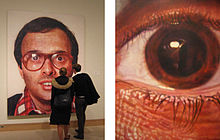During the 1970s a movement that was never clearly defined as a movement came upon the art scene. The reason it was never clearly defined was because it was called many names. The movement was prominent, especially in the United States. Some named it Super-realism, others said it was Photo-realism, and then there was those that referred to it as Hyper-realism, while others said it was Sharp-Focus-Realism. The art world couldn’t quite make up its mind. I’ll let you decide.
Many art critics rejected the work as being regressive, but at the time very popular with dealers, collectors, and the general public. This style of painting recognizes the importance of photography in art. The characteristics is of an impersonal, almost cool, appearance, and a certain preoccupation with common or industrial subjects painted with such great attention to detail that it has almost a scientific approach.
Richard Estes’ oil on canvas, “Telephone Booths” is an example of his Photo-realist technique, which was working from several photos of a scene, combining aspects to create images of uniform focus. It seems to be more real than a photograph…it appears to be a row of mirrors, created by reflective glass and metal that tends to confuse the viewer.
Mr. Estes (b.1932) is considered one of the founders of Phot0-realism. His paintings consisted mostly of inanimate city and geometric landscapes.

Chuck Close’s massive painting “Mark” (See picture to the extreme left to see size) is a perfect representation of Super-realism, or more aptly, Photo-realism. He created the images by transferring a photograph on a grid and painted square by square with airbrush and minimal amount of pigment. Using this method he achieved a smooth photograph like surface. He retained the out of focus area of the photograph with his painstaking attention to detail.
Close made a decision to make art difficult for himself in 1967. He threw all his art tools away. He felt the choice ‘not’ to do something was a more positive choice than to do something. It forced an artistic breakthrough by abandoning the paintbrush.
